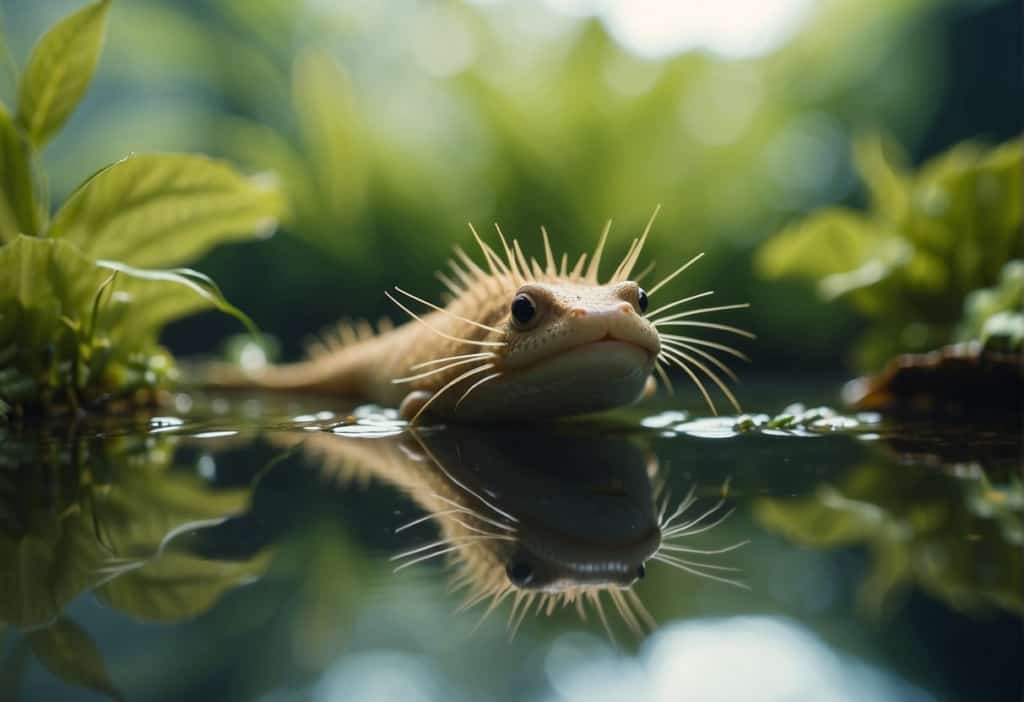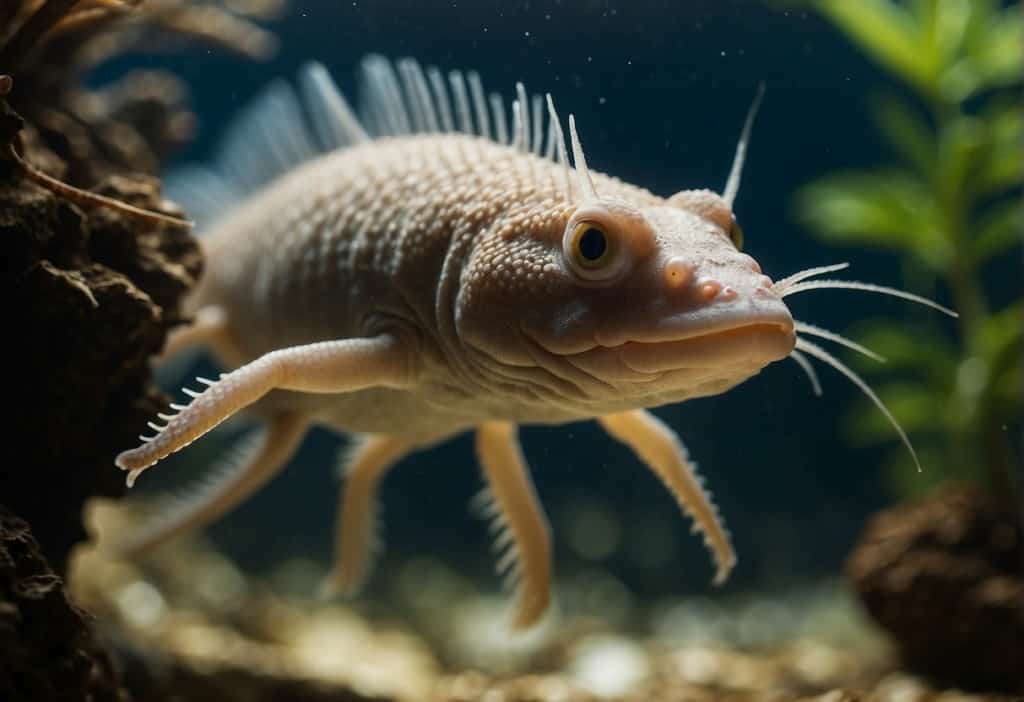Brown Axolotl Care: Optimal Habitat & Diet Tips
The brown axolotl, a unique variation of the Mexican axolotl, stands out with its earthy hue, blending seamlessly into its aquatic environment. Unlike other pet options, brown axolotls require specific care due to their delicate nature. As you consider a brown axolotl as a pet, understanding their requirements is crucial for their health and well-being. These creatures are not just captivating because of their color; they possess fascinating regenerative abilities that allow them to recover from injuries that would be permanent in most other species.

In their natural habitat, brown axolotls thrive in the still waters of lakes and canals, displaying a set of behaviors that are as intriguing as their appearance. They are primarily carnivorous, preying on small fish and invertebrates, which constitutes the majoirity of their diet. The care for these exotic pets extends beyond regular feeding; maintaining clean, cool water and a stress-free environment is essential. For those interested in breeding brown axolotls, understanding their genetic makeup and morphological variations can be both challenging and rewarding.
Key Takeaways
- Brown axolotls are a distinctive pet requiring specialized care.
- Their carnivorous diet and natural habitat behaviors must be replicated in captivity.
- Breeding them involves a deep understanding of their genetic diversity.
Physical Characteristics of Brown Axolotls

Brown axolotls display distinct features that differentiate them from other morphs. These include specific body size, pigmentation patterns, and unique gill structures.
Size and Body Structure
Your brown axolotl typically has a robust body with a well-defined head and a tail that tapers to a fine point. They often reach a length of about 9 to 12 inches as adults, though their size can vary slightly based on environment and health.
Color and Pigmentation
The color of a brown axolotl is determined by the presence and distribution of chromatophores, which are pigment cells. Specifically, melanophores (black pigment), xanthophores (yellow pigment), and iridophores (reflective pigment) contribute to the brown coloration.
Brown axolotls usually possess a dense arrangement of melanophores, giving them their characteristic color, which is accompanied by lighter spots or highlights where xanthophores and iridophores are present.
Gill Structure
Notice the feathery gills on your brown axolotl; they protrude from the back of the head, providing a large surface area for oxygen exchange.
These gills are often a reddish hue, laced with fine, blood-filled capillaries, but can vary slightly depending on the particular morph of the brown axolotl.
Some individuals exhibit gill filaments that contain more melanophores or iridophores, which can affect the coloration of the gills.
By understanding these characteristics, you can better appreciate the unique aspects of brown axolotls and ensure proper identification and care.
Behavior and Habitat
In understanding the brown axolotl, it’s crucial to explore their distinctive behaviors and habitats. These aspects are key to their survival and pivotal in their classification as critically endangered species.
Typical Behavior Patterns
Axolotls exhibit a range of behaviors that reflect their adaptive nature to aquatic environments. Foraging at night, these salamanders are primarily carnivorous, feeding on small prey like worms and insects.
During breeding season, axolotls engage in a mating dance, where the male deposits sperm packets (spermatophores) which the female retrieves to fertilize her eggs.
- Daily Routine: Axolotls are largely inactive during the day, preferring to hide under rocks or in mud.
- Social Interaction: While often solitary, when under human care, axolotls may exhibit social behaviors with other axolotls.
Natural Habitats
Wild type axolotls are native to the lake complex of Xochimilco, near Mexico City. Their habitats are freshwater, rich in vegetation and often muddy. However, pollution and urban expansion have critically endangered their natural ecosystems, resulting in significant habitat loss.
- Preferred Conditions: Clean, cool water with abundant vegetation and low light.
- Survival Threats: Environmental stresses like habitat destruction and water contamination.
Life in Captivity
In captivity, brown axolotls – an axanthic variation lacking certain pigments – adapt well given proper care. They require a well-maintained aquarium with cool, filtered water and a mud or fine gravel substrate for burrowing.
Axolotls are often kept as pets and the conditions of their environment significantly affect their welfare, including growth and behavioral patterns. When breeding axolotls in captivity, attention to the temperature, water quality, and diet is essential for successful egg laying and hatching.
- Aquarium Setup: A tank with at least 10 gallons of water per axolotl, hiding places, and no strong current.
- Diet: A varied diet can enhance the welfare and growth of captive axolotls; it typically includes worms, small fish, and specially formulated pellets.
Axolotls’ resilience and unique life in and out of the wild continue to fascinate enthusiasts and researchers alike, marking them as remarkable yet vulnerable inhabitants of our world.
Diet and Nutrition
When caring for your axolotl, understanding their dietary needs is crucial for their health. Axolotls are primarily carnivorous and require a diet high in protein to thrive.
As pets, they do well on a variety of live and prepared foods. You should aim for a balanced diet to promote proper growth and vitality.
Here’s what you need to know about feeding your axolotl:
- Live Food: Live food options include earthworms, bloodworms, and blackworms. These are ideal as they mimic the axolotl’s natural hunting instincts.
- Pellets: Specially formulated axolotl pellets provide a convenient and nutritious option. Ensure they are high in protein and have a soft texture.
- Frozen Food: Frozen bloodworms and brine shrimp can be fed to your axolotl as a supplement to their main diet.
Remember to feed young axolotls once a day and adults every other day. Overfeeding can lead to health issues, so it’s essential to monitor their food intake.
| Axolotl Food Type | Frequency | Notes |
|---|---|---|
| Live Food | Daily for juveniles, every other day for adults | Provide variety and mimic natural diet |
| Pellets | As part of regular meals | Ensure they are high quality and specifically for axolotls |
| Frozen Food | Occasionally | Use as a supplement to live food or pellets |
Always remove uneaten food promptly to maintain water quality in your pet’s tank. Proper nutrition is key in keeping your axolotl healthy, so take care in selecting food that meets their specific needs.
Health and Care
Maintaining the well-being of your brown axolotl involves addressing their specific health issues, setting up their tank correctly, and keeping the water parameters in check.
Common Health Issues
Axolotls can face several health issues, which you need to be aware of to ensure timely care.
- Infections: Bacterial and fungal infections are common in axolotls, often arising from poor water quality or injuries. Watch for signs like lethargy, reduced appetite, or unusual spots on the skin.
- Impaction: This can occur if axolotls ingest gravel or other indigestible materials, leading to gastrointestinal blockages. To prevent this, use fine sand or slate as a substrate.
Proper Tank Setup
The tank setup is crucial for the health of your axolotl pet. Here’s a basic checklist for setting up an adequate living environment:
- Tank size: Aim for at least a 20-gallon tank for one axolotl to give them enough space to move around.
- Substrate: A fine sand substrate helps prevent impaction, which can be life-threatening for your pet.
- Hides and Plants: Provide hides and plants to mimic their natural habitat and give your axolotl places to retreat.
Water Parameters
Keeping the water parameters within the ideal range is essential for your axolotl’s health.
| Parameter | Ideal Range |
|---|---|
| Temperature | 60-64°F (15-18°C) |
| pH | 6.5-7.5 |
| Ammonia | 0 ppm |
| Nitrite | 0 ppm |
| Nitrate | < 20 ppm |
Weekly water tests are a good practice to monitor these parameters, ensuring the environment remains safe for your axolotl. Change 20% of the water each week to maintain cleanliness and reduce the risk of health issues.
Breeding and Genetics
Breeding brown axolotls involves understanding their unique genetics, which dictate the variations in their color and patterning. Mastery of breeding techniques and morph identification is essential for success in producing specific axolotl traits.
Breeding Techniques
When breeding axolotls, your key objective is to ensure that both the male and female are healthy and mature. They generally reach sexual maturity by 18 months.
You can stimulate breeding through cycling temperatures or simulating rainfall in their habitat. Female axolotls lay numerous eggs, often more than 500, sticking them to plants and other surfaces in the breeding tank.
Genetic Variations
Genetic factors play a significant role in the variations seen among axolotl morphs. Mutations can produce a range of colors and patterns, including speckles, piebald characteristics, and even albinism.
For instance, an axolotl’s lack of pigment, resulting in an albino morph, is due to a genetic recessive trait.
- Common Genetic Variations in Axolotls
- Wild Type: Dark with greenish speckles
- Melanoid: Uniformly dark, lack reflective iridophores
- Albino: White or golden with red eyes
- Leucistic: Pale with pink eyes and no melanin
- Piebald: Leucistic with speckled pigmentation
- Axanthic: Lacking yellow pigments
Morph Identification
You’ll find it advantageous to identify axolotl morphs by examining their coloration and patterns. Albinism presents as a complete lack of pigment, while patches of unpigmented skin characterize the piebald morph alongside normal coloring.
Each morph type has its genetic code, which can be used to predict breeding outcomes and aid in the production of desired morphologies in offspring.
Axolotl Varieties and Morphs
The axolotl, known scientifically as Ambystoma mexicanum, offers an astounding array of colors and patterns, with each morph presenting distinct physical characteristics.
Common and Rare Morphs
Common Morphs: These typically include wild type, which sports a combination of green, brown, and black colors, and the leucistic axolotl with its pinkish-white body and red or black eyes. The wild type is commonly spotted in nature, exhibiting a mottled pattern that provides excellent camouflage.
Rare Morphs: Among the rarer finds, you might encounter the captivating piebald axolotl, which displays scattered pigmentations on a white base, or perhaps the elusive chimera variant, which appears to be split down the middle, exhibiting two different colors.
The firefly axolotl is a particularly unique creation, exhibiting fluorescent tails grafted from GFP axolotls that glow under black light.
Color Spectrum in Axolotls
The standard color palette for axolotls ranges from black to white, and even vibrant hues like gold and silver. Albino axolotls are devoid of pigment, often displaying a golden or white appearance, whereas copper axolotls show off a metallic sheen.
The diversity stretches to the golden albino that features a yellowish-gold tone with shiny eyes.
- Dark Morphs: span from black axolotls to gray variants.
- Light Morphs: include the subtle shades of white albino or tan axolotls.
Genetic Traits of Axolotl Colors
Axolotls owe their diverse coloration to specific genetic traits, which dictate whether they will display features like a golden sheen or the absence of coloration known as albinism.
The mosaic axolotl is a genetic wonder, a blend of different cells that result in a mix of colors—no two mosiacs are alike.
The genetics behind GFP (Green Fluorescent Protein) allow GFP axolotls to glow under ultraviolet light. Another rare genetic variation is seen in enigma morphs, which display irregular patterns and can vary widely between individuals.
- Genetic Markers for Coloration:
- Eumelanin: Results in black or brown shades
- Pheomelanin: Leads to reddish or tan tones
- Albinism: Absence of pigment leading to white or golden colors
The exploration of axolotl types can provide you with a deeper understanding of how to identify these numerous morphs and appreciate their unique beauty.
